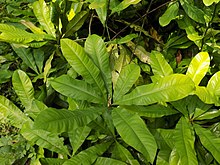| Ancistrocladus korupensis | |
|---|---|

| |
| Conservation status | |
 Endangered (IUCN 3.1) | |
| Scientific classification | |
| Kingdom: | Plantae |
| Clade: | Tracheophytes |
| Clade: | Angiosperms |
| Clade: | Eudicots |
| Order: | Caryophyllales |
| Family: | Ancistrocladaceae |
| Genus: | Ancistrocladus |
| Species: | A. korupensis |
| Binomial name | |
| Ancistrocladus korupensis Thomas and Gereau, 1993 | |
Ancistrocladus korupensis is a species of liana endemic to southwestern Cameroon and the neighbouring regions of Nigeria. The type locality is Korup National Park. The plant was identified as new to science in 1993 after pharmacologically intriguing alkaloids were found in its leaves.
Description
Like other members of its genus Ancistrocladus, this plant starts life as a free-standing bushy plant, with rosettes of eight to ten long leaves at the tip of each branch. When the sapling is three or four metres tall, one shoot develops into an aerial, hooked stem with alternate long leaves, which quests upward in search of a host. When this stem is established in a tree, the rosettes at the base die off. The flowers have yellowish-green sepals, pinkish or yellowish petals, ten stamens in two whorls and three styles. The fruits have five wings. They do not disperse very far, and the function of the wings seems to be to position the fruits correctly for germination rather than to disperse them.
Distribution and habitat
Ancistrocladus korupensis seems to be restricted to the Korup National Park, in Southwest Province, Cameroon. Isolated populations nearby include one in eastern Nigeria. The liana grows in acidic, nutrient-poor soil conditions, typically in sandy soils with a low clay content and low available phosphorus at altitudes of up to 160 m (525 ft). The trees up which it grows are also suited to these environmental conditions, the most common host trees being Oubanguia alata, Microberlinia bisulcata, Strephonema pseudocola, and Cola rostrata.
Research
Mature leaves of Ancistrocladus korupensis contain michellamine A, B and C, atropisomeric alkaloids which have been found to inhibit HIV viral replication. Michellamine B is particularly active against the NID-DZ strain of HIV-2, which is mainly found in West Africa. The National Cancer Institute considers michellamine B to have considerable potential for use against HIV because of its particularly effective mode of action. Additionally, novel alkaloids korupensamines A, B, C and D, with anti-malarial activity, have been isolated from the plant.
References
- Cheek, M. (2014). "Ancistrocladus korupensis". IUCN Red List of Threatened Species. 2014: e.T200681A2678768. doi:10.2305/IUCN.UK.2014-3.RLTS.T200681A2678768.en. Retrieved 28 October 2021.
- Foster, Paul F.; Sork, Victoris L. (1997). "Population and genetic structure of the West African rain forest liana Ancistrocladus korupensis (Ancistrocladaceae)". American Journal of Botany. 84 (8): 1078–1091. doi:10.2307/2446151. JSTOR 2446151. PMID 21708663.
- ^ Thomas, Duncan W.; Gereau, Roy (1993). "Ancistrocladus korupensis (Ancistrocladaceae): A new species of liana from Cameroon". Novon. 3 (4): 494–498. doi:10.2307/3391401. JSTOR 3391401.
- Schlauer, Jan; et al. (1998). "Characterization of enzymes from Ancistrocladus (Ancistrocladaceae) and Triphyophyllum (Dioncophyllaceae) catalyzing oxidative coupling of naphthylisoquinoline alkaloids to michellamines". Archives of Biochemistry and Biophysics. 350 (1): 87–94. doi:10.1006/abbi.1997.0494. PMID 9466824.
- Zhang, Heping; Zembower, David; Chen, Zhidong (1997). "Structural analogues of the michellamine anti-HIV agents. Importance of the tetrahydroisoquinoline rings for biological activity". Bioorganic & Medicinal Chemistry Letters. 7 (1): 2687–2690. doi:10.1016/S0960-894X(97)10057-9.
- Marx, P.A.; Alcabes, P.G.; Drucker, E. (2001). "Serial human passage of simian immunodeficiency virus by unsterile injections and the emergence of epidemic human immunodeficiency virus in Africa". Philosophical Transactions of the Royal Society of London B: Biological Sciences. 356 (1410): 911–920. doi:10.1098/rstb.2001.0867. PMC 1088484. PMID 11405938.
- Everhart, Derald (7 April 1993). "Scientists Say Rare Vine Offers Hope For AIDS Cure". AP News. Retrieved 15 October 2021.
- Hallock, Yali F.; Manfredi, Kirk P.; Blunt, John W.; Cardellina II, John H.; Schaeffer, Manuela; Gulden, Klaus-Peter; Bringmann, Gerhard; Lee, Angela Y.; Clardy, Jon (1994). "Korupensamines A-D, novel antimalarial alkaloids from Ancistrocladus korupensis". The Journal of Organic Chemistry. 59 (21): 6349–6355. doi:10.1021/jo00100a042.
| Taxon identifiers | |
|---|---|
| Ancistrocladus korupensis | |